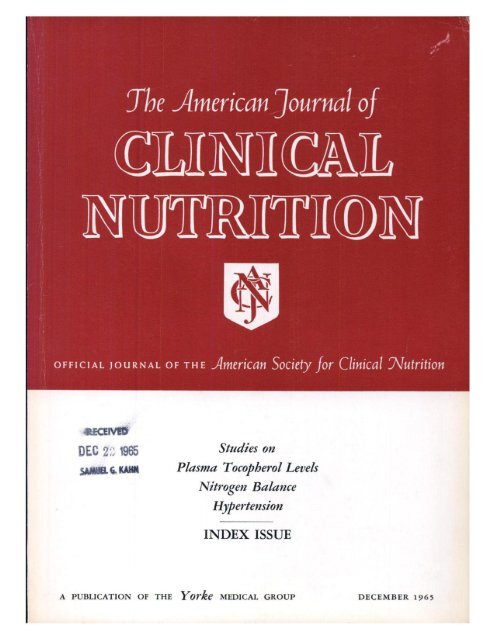Inflammatory and insulinemic dietary and lifestyle patterns and incidence of endometrial cancer: the multiethnic cohort
IF 6.5
1区 医学
Q1 NUTRITION & DIETETICS
引用次数: 0
Abstract
Background
The incidence of endometrial cancer (EC) is increasing, particularly among racial and ethnic minority groups. Obesity is an established EC risk factor, and obesity-related inflammation and hyperinsulinemia may play an important role in EC etiology.
Objectives
We examined the association of 5 empirical hypothesis-oriented dietary and lifestyle indices, which assess the inflammatory and insulinemic potentials of diet and lifestyle, with risk of EC in ethnically diverse females.
Methods
We included 60,441 female participants from the multiethnic cohort study, a cohort-based in the United States, who were African American, Japanese American, Latino, Native Hawaiian, or White, aged 45–75 y at baseline in 1993–1996. Using a quantitative food frequency questionnaire at baseline, we computed the empirical dietary inflammatory pattern (EDIP), empirical dietary index for hyperinsulinemia (EDIH), empirical lifestyle index for hyperinsulinemia (ELIH), empirical dietary index for insulin resistance (EDIR), and empirical lifestyle index for insulin resistance (ELIR). Multivariable Cox models adjusting for known risk factors for EC were used to calculate hazard ratios (HRs) and 95% confidence intervals (CIs) for the association between each index (using quintiles) and EC risk.
Results
We identified 1328 incident EC cases with a median follow-up of 25.2 y (IQR = 7.4 y). Females with higher ELIH had an increased risk of EC (HRQ5vsQ1 = 2.58, 95% CI: 2.16, 3.09; Ptrend < 0.01). Similarly, higher ELIR was significantly associated with an increased risk of EC (HRQ5vsQ1 = 2.89, 95% CI: 2.37, 3.53; Ptrend < 0.01). EDIP, EDIH, and EDIR were not associated with EC risk. Increased risk of EC with ELIH (all Ptrend < 0.01) and ELIR (all Ptrend < 0.01) was found in all racial and ethnic groups.
Conclusions
In this ethnically diverse cohort, lifestyle patterns with higher insulinemic potential were associated with an increased risk of EC. Lifestyle changes that include more physical activity and achieving a healthy body weight, in addition to reducing insulinemic and diets, may lower EC risk.
炎症性和胰岛素性饮食和生活方式模式与子宫内膜癌的发病率:多种族队列。
背景:子宫内膜癌(EC)的发病率正在上升,特别是在少数民族和种族群体中。肥胖是确定的EC危险因素,肥胖相关炎症和高胰岛素血症可能在EC病因学中起重要作用。目的:我们研究了五种以实证假设为导向的饮食和生活方式指数,这些指数评估了饮食和生活方式的炎症和胰岛素潜能,与不同种族女性EC风险的关系。方法:我们纳入了60,441名来自多种族队列(MEC)研究的女性参与者,该研究是一个基于美国的队列,他们是非裔美国人、日裔美国人、拉丁美洲人、夏威夷原住民或白人,1993-1996年基线年龄为45-75岁。在基线时使用定量食物频率问卷,我们计算了经验性饮食炎症模式(EDIP)、高胰岛素血症的经验性饮食指数(EDIH)、高胰岛素血症的经验性生活方式指数(ELIH)、胰岛素抵抗的经验性饮食指数(EDIR)和胰岛素抵抗的经验性生活方式指数(ELIR)。采用校正已知危险因素的多变量Cox模型计算各指标(使用五分位数)与EC风险之间关联的风险比(hr)和95%置信区间(CIs)。结果:我们确定了1328例EC病例,中位随访25.2年(IQR=7.4年)。ELIH较高的女性发生EC的风险增加(HRQ5vsQ1 = 2.58, 95% CI:(2.16, 3.09);PtrendQ5vsQ1 = 2.89, 95% CI: (2.37, 3.53);结论:在这个种族多样化的队列中,高胰岛素潜能的生活方式与EC风险增加相关。生活方式的改变,包括更多的体育活动和达到健康的体重,除了减少胰岛素和饮食,可以降低欧共体风险。
本文章由计算机程序翻译,如有差异,请以英文原文为准。
求助全文
约1分钟内获得全文
求助全文
来源期刊
CiteScore
12.40
自引率
4.20%
发文量
332
审稿时长
38 days
期刊介绍:
American Journal of Clinical Nutrition is recognized as the most highly rated peer-reviewed, primary research journal in nutrition and dietetics.It focuses on publishing the latest research on various topics in nutrition, including but not limited to obesity, vitamins and minerals, nutrition and disease, and energy metabolism.
Purpose:
The purpose of AJCN is to:
Publish original research studies relevant to human and clinical nutrition.
Consider well-controlled clinical studies describing scientific mechanisms, efficacy, and safety of dietary interventions in the context of disease prevention or health benefits.
Encourage public health and epidemiologic studies relevant to human nutrition.
Promote innovative investigations of nutritional questions employing epigenetic, genomic, proteomic, and metabolomic approaches.
Include solicited editorials, book reviews, solicited or unsolicited review articles, invited controversy position papers, and letters to the Editor related to prior AJCN articles.
Peer Review Process:
All submitted material with scientific content undergoes peer review by the Editors or their designees before acceptance for publication.

 求助内容:
求助内容: 应助结果提醒方式:
应助结果提醒方式:


